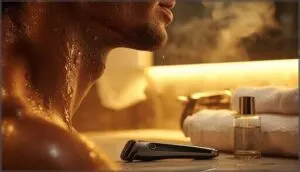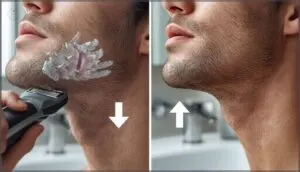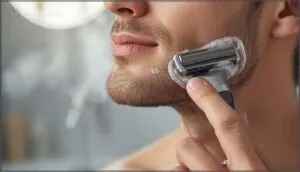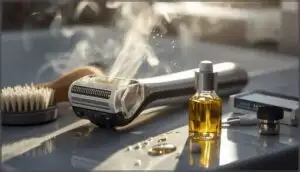This site is supported by our readers. We may earn a commission, at no cost to you, if you purchase through links.

Most people who switch to electric razors quit within the first week—not because the technology fails them, but because they’re still using manual razor techniques. That disconnect explains why some men swear by electric shavers while others dismiss them as ineffective gadgets that pull hair instead of cutting it.
The truth is, electric razors operate on completely different principles than blade shaving, requiring you to unlearn old habits and adopt new ones. Master the right technique, though, and you’ll discover why 75% fewer cuts and notably less irritation make electric shaving a major improvement for your morning routine.
The key lies in understanding how to work with your shaver’s design rather than against it.
Table Of Contents
Key Takeaways
- Most people quit electric razors in the first week because they’re using manual razor techniques instead of learning the completely different motions required—foil shavers need straight up-and-down strokes while rotary models work best with small circular patterns.
- Electric shavers deliver 75% fewer cuts than manual razors and reduce irritation by up to 40% when you use light pressure and limit yourself to one pass per area, letting the device do the work rather than pushing hard against your skin.
- Your skin needs 2-4 weeks to adapt to electric shaving, and proper prep makes the difference—trim hair under a quarter-inch first, stretch skin taut while shaving, and always follow up with alcohol-free moisturizer to lock in hydration.
- Regular maintenance determines whether your shaver performs well or poorly—clean after every use, lubricate blades weekly with light oil, and replace foils or rotary heads every 12-18 months when you notice pulling or decreased closeness.
Benefits of Shaving With an Electric Razor
Electric razors have earned their place in millions of grooming routines for good reason. If you’re wondering whether the switch from manual to electric is worth it, the advantages speak for themselves.
Here’s what makes electric shaving a smarter choice for many men.
Reduced Nicks and Cuts
One of the biggest advantages of switching to an electric shaver is shaving safety. Electric razors report 75% fewer cuts than manual razors, thanks to protective foils and guards that prevent direct blade contact with your skin.
Electric razors deliver 75% fewer cuts than manual razors through protective foils that shield skin from direct blade contact
Here’s why you’ll see better cut prevention:
- Rounded blade heads glide smoothly without catching skin
- Protective barriers shield you from sharp edges during each pass
- Adjustable speeds minimize hair tugging and irritation
- No exposed blades mean safer shave technique around jawlines
- Less pressure needed reduces razor burn and shaving rash
Proper razor maintenance and skin protection techniques make electric shavers your safest choice. Additionally, understanding the electric razor benefits can help you make an informed decision about your shaving needs.
Faster and More Convenient Shaves
Beyond safety, electric razors deliver outstanding shave efficiency. Your typical session takes just 5 to 7 minutes—cutting grooming time by half compared to manual methods. Quick grooming becomes second nature when you’re using electric shavers that operate at 14,000 cuts per minute.
Time savings add up fast since you don’t need shaving creams or water. These convenience features make shaving with electric razors ideal for busy mornings when you’re rushing out the door.
Electric shavers offer numerous benefits, including improved customer satisfaction ratings that elevate the overall shaving experience.
Versatility for Beard and Facial Hair Styles
Electric shavers excel at beard styling and facial hair versatility. Modern shaver attachments give you precise trimming tools for any look—from clean-shaven to sculpted beards. Here’s what men’s grooming experts recommend:
- Rotary models handle medium to coarse beards and longer stubble
- Foil razors deliver sharp lines and smooth finishes
- Multi-length settings let you experiment with different styles
- Pop-up trimmers shape sideburns and necklines with precision
You’ll master various shaving techniques without switching devices.
Less Need for Shaving Creams and Gels
You’ll skip shaving cream with most electric shavers, cutting your routine by 3-5 minutes per session. Dry shaving benefits include 30-50% less skin irritation compared to traditional methods—your face stays healthier without chemical exposure.
Electric shaver efficiency saves you roughly $40 yearly on products, and razor maintenance becomes simpler without clogged blades. These shaving techniques prove that shaving cream alternatives work better for daily grooming.
Lower Risk of Ingrown Hairs
Your skin stays smoother because electric shavers cut hair at or slightly above skin level, preventing those sharp tips from curling back into follicles. Hair follicle care improves dramatically—studies show electric shaving causes less trauma than manual razors.
Regular razor maintenance keeps blades sharp, reducing tugging that triggers bumps. Proper shaving techniques with light pressure and skin exfoliation before use complete your ingrown hair prevention strategy.
How to Prepare Your Skin for Electric Shaving
Getting a good shave starts well before you turn on your electric razor. The right prep work makes the difference between a smooth, comfortable result and a frustrating experience with irritation.
Here’s what you need to handle before you begin shaving.
Choosing The Right Electric Razor (Foil Vs. Rotary)
Your first decision matters more than you think—picking the right electric razor sets the stage for every shave ahead. Foil shavers deliver precision and closeness, ideal for daily routines and sensitive skin, while rotary shavers adapt to facial contours and handle coarser hair with ease.
- Foil shavers reduce irritation with hypoallergenic foils that minimize razor burn
- Rotary features excel at flexibility, capturing uneven growth with circular motion
- Shave quality improves when you match shaver types to your hair texture
- Skin considerations guide your choice—delicate skin thrives with foil technology
- Electric shaver versatility means you control beard styling and maintenance
Charging and Cleaning The Shaver Before Use
Before you run your new razor across your face, plug it in for a full 8–12 hour initial charging cycle—battery calibration begins here.
While it powers up, rinse the cutting head under water and use cleaning solutions to eliminate factory oils.
These pre-use checks and electric shaver maintenance steps guarantee shaver hygiene and proper electric razor maintenance from day one.
Facial Hair Assessment and Pre-Trim Tips
Your beard’s length and density determine whether your electric shaver will glide smoothly or struggle. Hair Length Evaluation is straightforward—if your facial hair exceeds a quarter-inch, use Trimming Techniques with a beard trimmer first.
Pre-Shave Hydration softens stubble; press a warm cloth against your face for 2–3 minutes. Proper Skin Preparation and evaluating Facial Hair Density set up every electric shaver pass for success.
Stretching Skin for Optimal Results
Pulling your face taut before you shave isn’t optional—it’s what separates a mediocre result from a close, comfortable finish. Skin Tension lifts facial hair upright, letting your Electric Shaver capture stubble efficiently.
Use your free hand to stretch Facial Contours along your jawline or neck, adjusting Shaving Angles for Razor Efficiency. Proper Skin Stretching transforms every pass into a cleaner cut.
Step-by-Step Electric Shaving Techniques
Now that your skin’s prepped and your shaver’s ready, it’s time to put the right techniques into action. The way you move your razor, the pressure you apply, and the direction you shave all make a real difference in your results.
Here’s what you need to know to get a close, comfortable shave every time.
Correct Shaving Motions for Foil and Rotary Razors
Your electric shaver type dictates your motion strategy. Foil shavers work best with straight, up-and-down strokes—think painting a wall—while rotary shavers thrive on small, overlapping circles. Here’s what you need to know:
- Use linear strokes for foil shavers to optimize blade contact
- Apply gentle circular motions with rotary shavers for contoured areas
- Keep pressure light—let the shaver do the work
- Stretch skin taut for cleaner passes and fewer missed hairs
Shaving With The Grain Vs. Against The Grain
Once you’ve mastered your shaver’s motion, it’s time to tackle grain direction. Shaving with the grain—following your hair’s natural growth—greatly reduces irritation and cuts the risk of ingrown hairs. Against the grain delivers a closer shave but increases redness and razor bumps, especially on sensitive skin. Start with the grain, assess your comfort level, then decide if you need that extra closeness.
| Shave Direction | Pros | Cons |
|---|---|---|
| With the Grain | Minimizes skin irritation; reduces ingrown hairs by 30-40%; ideal for sensitive or acne-prone skin | Leaves slightly more stubble; may require touch-ups sooner |
| Against the Grain | Achieves closer shave; cuts hair below skin surface for smoother finish | Higher risk of razor burn, folliculitis, and trapped hairs; 57.6% experience immediate redness |
| Hybrid Approach | Balances closeness with comfort; allows customization based on skin response | Requires careful monitoring; not suitable for all skin types |
Applying The Right Pressure and Angle
You’ve nailed your direction, but pressure and angle determine whether you finish smooth or irritated. Think of your electric razor as a precision tool—let it do the work. Experts consistently recommend minimal force: Philips notes that excessive pressure causes inflammation and faster blade wear, while Braun warns it triggers heat buildup leading to redness.
Here’s your pressure playbook:
- Light Touch Wins: Hold your shaver with just enough contact to guide it—no pushing or digging into skin
- Angle Matters: Keep foil shavers near 30° for ideal cutting; rotary shavers work best between 30-45° following facial contours
- Gentle Strokes Rule: Use smooth, controlled movements and let rotating or oscillating blades capture hair naturally without force
Research shows improper technique increases erythema by over 50% compared to correct pressure. Your skin will thank you.
Strategies for Sensitive and Hard-to-Reach Areas
Your neck and jawline demand extra care—these zones are where most irritation happens. Start shaving sensitive areas first, before your electric shaver heats up, cutting irritation by 24%.
Stretch skin gently to lift flat-lying hairs and improve capture on facial contours. For hard-to-reach areas under your chin, slow down and adjust angles frequently.
Consider wet shaving with gel on sensitive skin to lower razor burn by 17%.
Avoiding Multiple Passes Over The Same Area
Once you’ve covered an area, move on. Going over the same spot repeatedly increases micro-abrasions by 35% and razor burn risk by up to 40%.
Apply light pressure—it cuts irritation by 40% compared to a heavy-handed technique. Maintain a 90-degree angle and use short, controlled strokes for shave efficiency.
With proper skin preparation and razor maintenance, you’ll achieve a close shave without damaging your skin through unnecessary passes.
Post-Shave Skin Care Essentials
Your shave doesn’t end when you turn off the razor. What you do in the next few minutes determines whether your skin stays smooth and comfortable or becomes red and irritated.
Let’s cover the essential post-shave steps that protect your skin and keep it looking its best.
Rinsing and Soothing The Skin
Once you finish shaving, cold water rinsing becomes your first line of defense against irritation. Splashing your face multiple times closes pores, tightens skin, and calms razor burn—especially in sensitive areas like your neck where over 60% of electric razor users experience discomfort.
- Pat dry gently with a soft towel to avoid friction
- Wait a few minutes before applying post-shave care products
- Use natural skin soothing ingredients like aloe vera for facial hydration
Using Alcohol-Free Aftershave or Moisturizer
Your skin loses moisture during shaving, so hydration matters. Choose an alcohol-free aftershave or moisturizer with ingredients like vitamin E or aloe vera—they reduce post-shave irritation by up to 70% for sensitive skin while boosting moisture retention markedly.
These aftershave benefits include calming redness and strengthening your skin barrier, making post-shave care essential for anyone serious about proper shaving techniques and tips.
Treating and Preventing Irritation
Understanding irritation causes helps you act fast when razor burn strikes. If redness appears, rinse immediately with cool water to close pores and remove debris. Apply soothing, alcohol-free aftershave containing aloe vera or chamomile to calm burning sensations—studies show over 40% of men with sensitive skin experience these reactions.
For irritation prevention and better skin care:
- Wait 2-3 minutes with a warm washcloth before shaving to soften hairs
- Start on your neck first, before foils heat up
- Limit passes over the same spot to reduce friction
- Clean your razor every 3-4 uses to prevent buildup
- Replace blades annually to avoid hair pulling
Skip shaving over already irritated areas—let your skin heal naturally. Proper shaving techniques combined with hydrating post-shave products cut recovery time from days to hours.
Tips for Sensitive or Easily Irritated Skin
Your skin’s unique needs deserve special attention when choosing an electric razor. SensoFlex heads and AutoSense technology reduce irritation by over 29% in sensitive users, making them worth the investment. Here’s your quick-reference guide:
| Skin Preparation | Gentle Techniques |
|---|---|
| Hydrate 3+ minutes with warm water | Use slow, deliberate motions |
| Exfoliate before shaving | Shave with the grain first |
| Choose anti-friction coatings | Apply minimal pressure |
| Test waterproof models for flexibility | Limit passes to one per area |
For irritation reduction, maintain your shaver with regular cleaning and blade replacement every 6-12 months—proper shaver maintenance cuts tugging incidents by 34%.
Dry shaving works better for 62% of users with skin sensitivity, so experiment to find what suits your sensitive areas best.
Maintaining and Caring for Your Electric Razor
Your electric razor won’t perform at its best unless you maintain it properly. Regular cleaning, lubrication, and timely blade replacement are what separate a mediocre shave from a consistently smooth one.
Here’s how to keep your shaver in top condition so it delivers the close, comfortable shave you’re after.
Cleaning Procedures After Each Use
Regular cleaning keeps your electric razor performing like it did on day one. After every shave, you’ll want to follow these essential steps:
- Tap and brush away hair from the shaving head using the fine brush that came with your electric shaver
- Spray with alcohol-based disinfectant to kill bacteria hiding in the blades
- Rinse waterproof models under running water to flush out trapped debris
Let everything air dry completely before storing.
Lubricating Blades and Metal Parts
Think of lubrication as your electric razor’s lifeblood—without it, friction wears down blades and corrodes metal parts fast. Apply a few drops of light mineral oil or spray lubricant once or twice weekly to boost shaver efficiency and reduce heat buildup.
After cleaning with soap, you’ll need to oil more often since water strips away protective layers, keeping your blade maintenance on point.
Replacing Foils and Rotary Blades
Keeping your electric shaver lubricated isn’t the final step—blade replacement separates okay shaves from great ones. Most manufacturers recommend foil maintenance every 12–18 months, while rotary care requires annual blade swaps. Watch for these signs:
- Your shave feels less close, requiring extra passes
- You notice pulling or tugging on hairs
- The shaving head heats up excessively during use
- Visible damage appears on foils or rotary blades
Replace parts immediately when performance drops.
Proper Storage and Hygiene Practices
After replacing blades, focus on where you store your razor—it matters more than you think. Keep your shaver in a dry, cool spot away from bathroom humidity, which causes rust and bacterial growth.
Use a protective case or stand to promote air circulation between uses. Clean your razor thoroughly before storing it, and never coil cords tightly around the device to prevent wire damage.
Signs It’s Time for Replacement Parts
Even with excellent storage habits, your blades won’t last forever. Watch for dull blades pulling or tugging at hairs instead of cutting cleanly—a clear replacement sign.
Worn foils cause increased irritation and take longer to deliver results. Most manufacturers recommend changing foils and razor blades every 12 to 18 months, though daily shavers may need replacement sooner for peak blade efficiency.
Frequently Asked Questions (FAQs)
Can I use electric razors on wet skin?
Yes, you can use electric razors on wet skin, but only with waterproof models. Around 60-70% of modern electric shavers handle wet shaving safely, reducing skin irritation by up to 25%.
How long does a full charge typically last?
Most electric razors deliver 30 to 60 minutes of cordless runtime on a full charge—enough for roughly 20 shaves.
Battery types like lithium-ion improve battery life, while consistent charging habits prolong battery lifespan.
What causes razor burn with electric shavers?
Too much pressure scrapes skin cells around hair shafts, creating micro abrasions and razor burn. Dull blades, aggressive strokes, and shaving against the grain increase physical abrasion and skin irritation.
Should I shave daily or skip days sometimes?
Your shaving frequency depends on hair growth rate and skin sensitivity. Daily shaving works well for most, but skipping a day or two between shaves helps reduce skin irritation if you notice redness.
Can electric razors work on thick coarse hair?
Absolutely. Rotary shavers excel at handling thick beard growth and dense stubble—they won’t bog down like some foil models. Look for powerful motors and sharp blades designed specifically for coarse hair electric shaver usage.
Conclusion
Think of electric shaving like learning to ride a bike—awkward at first, then second nature once muscle memory kicks in. The difference between frustration and a consistently smooth shave comes down to technique: correct motions, proper pressure, and giving your skin time to adjust.
Now that you know how to shave with an electric razor the right way, those first few shaves will build the foundation for faster, more comfortable mornings ahead.
- http://thecloseshave.com/mapping-your-beard-grain/
- https://www.consumerreports.org/electric-razors/
- https://www.healthline.com/health/skin-care-tips
- https://topelectricshavers.net/shaving/electric-razor-safety-myth-busting-guide-to-cut-free-shaving/
- https://www.acne.org/blade-shaving-vs-electric-shaving-which-is-better-for-your-skin











